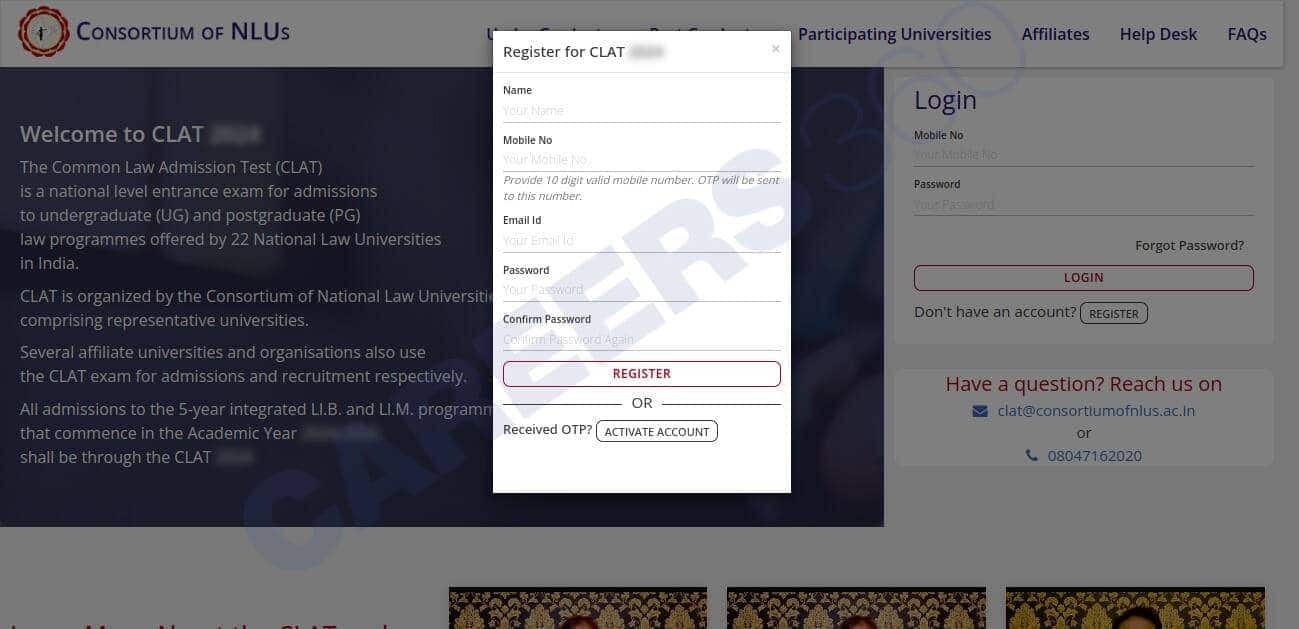Amity University-Noida Law Admissions 2026
Among top 100 Universities Globally in the Times Higher Education (THE) Interdisciplinary Science Rankings 2026
The Consortium of National Law Universities (CNLUs) conducts CLAT 2026 for admission to undergraduate and postgraduate law programmes. The authorities opened CLAT 2026 application form at consortiumofnlus.ac.in. A link to fill CLAT application form 2026 is provided here. The consortium commenced the CLAT registration from August 1, 2025. Interested candidates can fill out the application form on CLAT 2026 official website. The CLAT 2026 registration last date is October 31, 2025. Candidates are often confused about how to fill the CLAT application form. In this article, candidates will know the step-by-step process of filling out their CLAT 2026 application form.

Through the Common Law Admission Test, candidates will be able to gain admission into 5-year LLB and LLM programmes. There are 24 NLUs are participating in CLAT, which offer around 3,400 seats in 5-year LLB and around 1,300 seats in LLM.
Event | Details |
Release of CLAT 2026 admission notification | July 20, 2025 |
Opening of CLAT 2026 application | August 1, 2025 (Started) |
CLAT 2026 registration last date | October 31, 2025 |
Release of CLAT 2026 admit card | 15 days before the exam |
December 7, 2025 from 2 pm to 4 pm |
Law aspirants must be aware of the CLAT 2026 eligibility criteria before filling the application form to avoid rejection of the application. Below are the points regarding the eligibility criteria of CLAT.
Criteria | Eligibility Criteria |
Educational Qualifications |
|
Minimum marks required in qualifying exam |
|
CLAT Exam Age Limit |
|
Features | Specifications |
Mode | Online |
CLAT application fee | General/ OBC/ NRI category: Rs. 4,000 SC/ ST/ BPL/ PWD category: Rs. 3,500 |
Steps |
|
To fill the CLAT 2026 application form, candidates have to visit the official website: consortiumofnlus.ac.in. The application form for CLAT 2026 will be released in online mode. Candidates are required to pay the required CLAT 2026 application fee and fill out the details to complete the application process. The steps to fill out the CLAT application form 2026 are given below:
Candidates can check the steps of how to fill CLAT 2026 application form below.
Step 1: CLAT 2026 Registration
Step 2: Filling out the detailed application form
Step 3: Uploading documents
Step 4: CLAT application fee payment
Step 5: Submission of the application form
Candidates can refer to the elaborated steps provided below for an idea of the step-wise procedure of how to fill CLAT form online.

Candidates have to complete the initial registration process to generate CLAT login credentials. Then, candidates have to provide their email ID and mobile number to set up their CLAT 2026 account. Candidates must preserve these login credentials as they would need to log in to their account at various stages of the CLAT 2026 admission process, like downloading the admit card, checking the result, and registering for the counselling.
In the second step, candidates will have to fill up the details in the CLAT application form 2026. These details include the following information:
Personal details: In this section, candidates will have to provide personal information regarding one’s name, parents' names, date of birth, and category.
Educational qualification: The candidate has to provide details about their educational qualification, namely Class 10 and Class 12 details.
Communication details: The applicant must provide the permanent address and communication address details. It must be noted that the entire admission and counselling process is conducted in online mode.
Uploading of documents: Candidates have to upload their passport-size photograph and signature as per the prescribed format and specifications.
Among top 100 Universities Globally in the Times Higher Education (THE) Interdisciplinary Science Rankings 2026
Ranked #18 amongst Institutions in India by NIRF | Ranked #1 in India for Academic Reputation by QS Rankings | 16 LPA Highest CTC
In the next step, the candidate will have to provide the CLAT 2026 exam centre preferences. A candidate can enter a maximum of three choices in the order of their preference. The Consortium of NLUs will allot the CLAT 2026 exam centre after considering the availability and the preferences submitted by the candidate.
The final step of the CLAT 2026 application process is payment of the prescribed CLAT application fee. After the CLAT 2026 application fee payment, candidates can complete the registration process. The CLAT 2026 application fee must be paid in online mode, and it is non-refundable. In the table below, candidates can find out the CLAT 2026 application fees.
CLAT 2026 Registration Fees
Category | Fees |
General/ OBC/ NRI category candidates | Rs. 4,000 |
SC/ ST/ BPL/ PWD category candidates | Rs. 3,500 |
On Question asked by student community
Hello,
CLAT or Common Law Admission Test, a national level examination, is conducted for admission to the law colleges and universities.
With your rank you can get mid tier NLUs and newer NLUs. Some of the Institutes are RGNUL Patiala, CNLU Patna, NLUT Agartala, etc. Keep a eye on the cut off scores and counseling rounds.
Here is a college predictor via your rank designed by Careers360.
https://law.careers360.com/clat-college-predictor
Check out the official website of Careers360 for more information regarding the colleges.
https://law.careers360.com/articles/clat-2026-rank-wise-college-list
Thank you.
Hello,
No, with a CLAT rank of 9515, it does not offer any admission to the University School of Law and Legal Studies.
As per the stats provided, USLLS BA LLB (Hons) lists the OBC category entries from 4600 to 5600 ranks.
For further clarifications visit
https://www.careers360.com/colleges/university-school-of-law-and-legal-studies-new-delhi/cut-off
Hope it helps with your query. Good luck.
Hello,
For your mentioned rank, the top elite law universities are constrained to be limited, especially when the chance is fairly divided among reserved category people.
But apart from CLAT rank, NRI admissions have some different processes.
Some NLUs handle counselling with required eligibility and quotas. The counselling registration window is open until December 27, 2025. You can apply to know through them. Because even missing application deadlines will lessen your eligibility.
NRI admissions regarding CLAT can be applied directly with the major required document proofs.
Cutoffs to 10,000 are being allotted after regular rounds for counselling, but the course fee for this will be 10-20 lakhs per annum only if the candidate is either of these: NRI, OCI, or PIO.
For further clarifications check the official portal
Consortium of (https://consortiumofnlus.ac.in/clat-2026/) NLUs.
Hope it helps with your query. Good luck.
Hello,
Here is your CLAT 2026 Rank-Wise College List - Available NLUs in your rank range. I am providing you the link. Kindly open and check it out.
https://law.careers360.com/articles/clat-2026-rank-wise-college-list
I hope it will help you. For any further query please let me know.
Thank you.
Hello,
With an OBC category rank of 2796 and All India Rank (AIR) 15163 in CLAT 2026, your chances of admission into a National Law University (NLU) are moderate too low for the top NLUs, but you may still secure a seat in some of the newer or lower-ranked NLUs depending on the cutoffs and counselling rounds.
For more access mentioned link below:
https://law.careers360.com/articles/nlu-cutoff
Hope it helps.
Among top 100 Universities Globally in the Times Higher Education (THE) Interdisciplinary Science Rankings 2026
Ranked #18 amongst Institutions in India by NIRF | Ranked #1 in India for Academic Reputation by QS Rankings | 16 LPA Highest CTC
AICTE & UGC Approved | NAAC A+ Accredited
NAAC A++ Approved | Curriculum Aligned with BCI & UGC
India's Largest University | BCI approved | Meritorious Scholarships up to 5 lacs |
Integrated Learning – A balanced blend of management and legal education